The Man with the Inkwell
Ezekiel 8-9
by Jeffrey J. Harrison
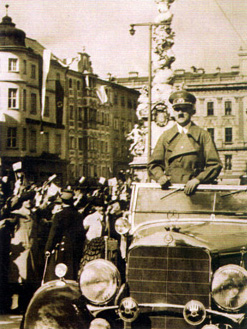
It’s not easy being God’s chosen people.
Jewish people sometimes say this with a twinkle in their eye, at other times a deep sigh. The hard reality of being chosen flickered again briefly before the eyes of the world when Pope John Paul II visited Yad Vashem, the Holocaust memorial in Jerusalem in March 2000. It was a somber meeting. There in the bare, bleak Hall of Remembrance many wept as they remembered the Nazis and the horrible atrocities committed against the Jewish people. Six million were killed, many in the gas chambers of the Nazi extermination camps. Others survived with a prisoner number tattooed on their arms.
This happened in supposedly Christian Europe, where many of those involved in the killing, including Hitler himself, were members in good standing of the Catholic church. Most of the others were Protestants. How could this happen? How could one group of God’s chosen people so brutally reject and kill another group of God’s chosen people? It’s the story of Cain and Abel taken to nightmarish proportions. Fortunately, there were a few who gave testimony to the true nature of Christ’s love by saving Jews from destruction.* But many, called to be witnesses of God’s love, became instead ministers of death. How could such darkness have penetrated into the hearts of the Christian people?
* Known in Israel as righteous Gentiles, or the righteous among the nations.
These are non-Jews who risked their lives to save Jews. They are also commemorated at Yad Vashem.

Unfortunately, the corruption and compromise of God’s people is a story that has played itself out over and over again throughout history. Ezekiel was forced to confront it when God snatched him up in a vision by the hand of a radiant, fiery man and brought him to Jerusalem (Eze. 8:2-3).* Here he saw spiritual darkness of a kind unparalleled in the Bible.
* This is the same radiant man Ezekiel saw in the chariot of God (Eze. 1:26-; see the article The Chariot).
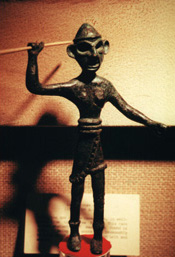
First, in one of the gates of the Temple—the massive stone doorways leading to the inner courts of Solomon's Temple—he saw the idol of jealousy
(Eze. 8:3). This was not just a visionary symbol. The book of Kings details the extremes of idolatry practiced in the Temple in this generation.* The placement of pagan idols in the gates of cities is well known from archeology. The choice of a northern gate may indicate that this was an idol of Baal, whose holy mountain was thought to lie north of Israel.
* 2 Kings 23 lists the idolatrous practices stopped by King Josiah, several of which were in the Temple itself. These evils, the sins of Manasseh,
were resumed by Josiah’s successors in the time of Ezekiel (2 Kings 24:3,19; 2 Chron. 36:14).
As shocking as this idol was, this was only the start. Ezekiel went through a hole in a wall to an inner chamber (Eze. 8:7-9), probably one of the rooms built along the wall surrounding the inner court. Here, in secret, was not just one false god, but dozens of them in the shape of insects and other creatures along with many other abominations carved into the stone walls, as in the temples of Egypt (Eze. 8:10). And worshipping these detestable gods were seventy of the elders of Israel (Eze. 8:11), the leaders of the nation, successors to the seventy elders appointed by Moses in the desert (Num. 11:16-17) and forerunners of the Sanhedrin Council in the time of Jesus.* Though their worship was in the right place—the Temple of God—they were no longer worshipping the right god. Their hearts had turned to idols and false religion.
*Though sometimes translated merely as "council," this is the Great Sanhedrin
that officiated in the Temple itself and before whom Jesus as well as Peter and Paul were arraigned (Matt. 26:59; Acts 5:27, 23:1).
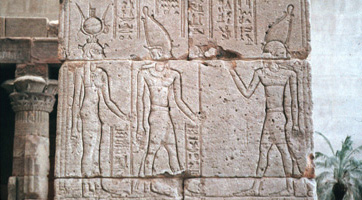
God never asked for these idols and images to be in his house. He forbid it! But they, in the rebellion of their hearts, unashamedly brought these things right into the presence of God. Why? They had given up on God (For they say,
Eze. 8:12). They still looked religious, going up to the Temple to pray. But in fact they had abandoned the God of the Bible in favor of false religion.The Lord does not see us; the Lord has forsaken the land,
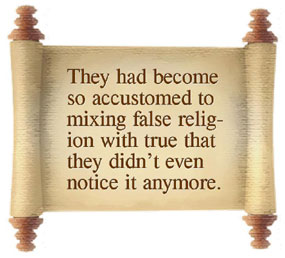
Next Ezekiel was taken to a gate where women were weeping for Tammuz (Eze. 8:13-14). Tammuz was a Babylonian god of fertility. Every year when the rain stopped in early summer and the land became dry, the worshippers of Tammuz wept for their god, whom they believed lay dead until the rains returned in the late fall. Did it bother these women that they were worshipping a false god in the House of the living God? It doesn’t seem so. They had become so accustomed to mixing false religion with true that they didn’t even notice it anymore.
Finally Ezekiel is taken to the inner court of the Temple (Eze. 8:15-16). Here, in front of the door of the Sanctuary, a group of men were prostrated in worship of the sun, their backs to the house of God.* This defiant act is called putting the twig to their nose
(Eze. 8:17), something like our expression thumbing the nose.
** How much of this would God endure? (Eze. 8:18).
* The Sanctuary, which Ezekiel calls the Temple
of the Lord (the heikhal), was the central building in the Temple compound. It housed the Holy Place and the Holy of Holies.
** This supreme insult was remembered in Jesus’ day in a special ceremony at the Feast of Tabernacles. After a night of rejoicing, and at the blowing of trumpets by two priests, they faced the Sanctuary and said, Our fathers, when they were in this place, turned
(Sukkah 5:4).with their backs toward the Sanctuary of the Lord and their faces toward the east...
; but as for us, our eyes are towards the Lord
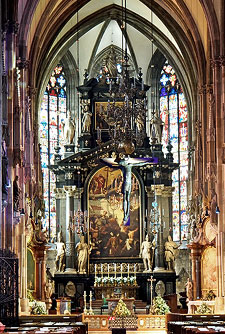
In the years before Hitler, many of the churches in Germany, as in many other parts of Europe and in America, became so liberal, they rejected the truth of the Bible. People continued to go to church, pastors continued to preach. But many were worshipping, some secretly, others openly, the false gods of evolution and higher criticism. With their words, they insulted God to his face in his own house. This helped clear the way for an especially virulent form of anti-Semitism, which in Germany gained government sanction and led to the Holocaust.
Today, these same false beliefs have led to perversion and immorality being openly accepted in many churches, reminiscent of the male cult prostitutes expelled by Josiah from the Temple (2 Kings 23:7). What could be more disobedient and more rebellious in the eyes of God? Yet in some places these things are accepted as a matter of course, or even as a sign of true religion. No one seems to notice the mixture with false religion, or to remember the saying of Jesus, If you love me, you will obey my commands
(John 14:15). Without obedience, there is none of what God calls love, only a fleshly, perverse imitation. How much more of this will God endure?
After Ezekiel had seen these things, the radiant, fiery man cried out in a loud voice. Immediately, six armed and dangerous men entered the inner court of the Temple, together with a man clothed in linen, who had an inkwell tied at his waist (Eze. 9:2).* Together they stood beside the bronze altar, the altar of sacrifice, in front of the Sanctuary of the Temple. Why here? The altar of sacrifice was a reminder of the harsh penalty that God has imposed for sin: death (Rom. 6:23).
* This group of seven (the six armed men and the man in linen) may be one of the sources of the traditional Jewish and Christian teaching of seven archangels. In some Jewish Christian circles, these were understood to be Jesus—the ultimate messenger
of God, who marks those to be saved—together with six created angelic beings (The Shepherd of Hermas 9.12.7; Jean Danielou, Theologie du Judeo-Christianisme, Desclee & Co., Paris, 1958, pp. 172-173).
The radiant, fiery man then instructed the man clothed in linen to go through the city and mark those sighing and groaning over the abominations taking place in Jerusalem (Eze. 9:4). Only those who received the mark would be saved. The six armed men were to follow him, destroying all who had not been marked (Eze. 9:5).
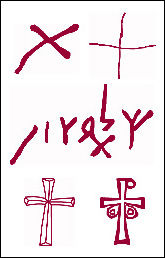
The mark
he puts on their foreheads translates the Hebrew word tav. In addition to meaning a mark, this is also the name of the last letter of the Hebrew alphabet. This was still occasionally written in Jesus’ day, as it was in the time of Ezekiel, as an equal-armed cross (see the cross in the upper right corner of the diagram).* In other words, the man with the inkwell was to mark people with a sign in the shape of a cross for them to be saved.** What an incredible foreshadowing this is of the ministry of Jesus! He, too, came to mark
those who sigh and groan over the abominations of our world, this time with a cross in memory of the bloody tree on which he gave his life.
* This was the shape of the letter tav in the paleo-Hebrew script used before the Babylonian Exile. This script was still remembered in the time of Jesus and appeared on certain coins as well as in several places among the Dead Sea Scrolls.
** The mark
mentioned in Ezekiel was understood to have Messianic significance in Jesus’ day. The Dead Sea community marked Messianic prophecies in their Bible scrolls with an equal-arm cross or x
shape (see the cross in the upper left corner of the diagram). They may also have had a ritual in which this marking was actually performed, with oil on the forehead, as a symbol of deliverance from the judgment to come.
*** This marking by Messiah also points back to the original Passover, when a bloody mark was put on the doors of people’s homes to keep them safe from the destroyer (Exo. 12:7,13). Christian tradition understands this Passover marking, too, to have been in the shape of a cross.
This marking on the forehead also appears in Revelation 7, where a mighty messenger of God marks the 144,000 of the remnant of Israel. This mark is described as the seal of the living God
(Rev. 7:2). This is the fulfillment of Isaiah’s prophesy: A remnant will return, a remnant of Jacob to the mighty God
(Isa. 10:21). But God is also looking for a remnant of the Gentiles: those willing to follow him and obey his will—no matter what the rest of the world is doing (Rev. 7:9). Are we sighing and groaning over the wickedness in the Church and in the world today? Or are we running after these deceptions like all the rest?
The work of the destroyers started from the Sanctuary (Eze. 9:6). As Peter put it: It is time for judgment to begin with the house of God: but if first with us, what will be the end of those who are disobedient to the gospel of God?
(1 Pet. 4:17). The prophecy of Ezekiel, and the actual destruction that soon followed, fell upon God’s own people and the holy city of Jerusalem.* If he did this to Israel because of their sins, do you think he will do any less to the Church when it compromises and corrupts the gospel?**
* Three years after Ezekiel’s vision, Jerusalem was besieged by King Nebuchadnezzar of Babylon (2 Kings 25:1-2). A nineteen month siege resulted in horrible famine, after which the city was conquered and destroyed (2 Kings 25:3-12).
** The churches of Germany, and the German nation as a whole, suffered horrible destruction in the aerial bombardment of the Allies and in the other fighting of World War II. But this is only a foreshadowing of the eternal judgment to come for those who rebel against God and reject his Word.
Why is it so hard to be the chosen people of God? Because when God judges the guilty, the innocent also suffer. Yet even in the midst of that suffering, he provides a way of escape. Those marked with the blood of the lamb will be spared the final and most devastating judgment. What about you? Do you see the world with the eyes of God? Do you weep over what he weeps about? Do you groan over what he groans about? Do you see the sin in your own life and weep about it before the Lord? It’s much harder to resist the stream of the world than to flow with it. But God has given us a higher calling: to be different than the world, to be a holy people, set apart from the rest, whatever the personal cost. It will be well worth it in the end.